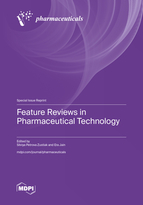Feature Reviews in Pharmaceutical Technology
A special issue of Pharmaceuticals (ISSN 1424-8247). This special issue belongs to the section "Pharmaceutical Technology".
Deadline for manuscript submissions: closed (30 March 2023) | Viewed by 55095
Special Issue Editors
2. Co-Director, Institute for Drug and Biotherapeutic Innovation, Saint Louis University, St. Louis, MO, USA
Interests: drug delivery; drug screening platforms; hydrogels; nanocomposites; glioblastoma
Interests: drug delivery; hydrogels; osteoarthritis; immunomodulation; musculoskeletal regeneration
Special Issues, Collections and Topics in MDPI journals
Special Issue Information
Dear Colleagues,
With the continual discovery of a plethora of new drug candidates, both small-molecule drugs and large biomolecules, pharmaceutical technologies are becoming essential for the advancement of patient treatments. These might include drug modifications, new formulations, or the use of delivery devices for drugs with unfavorable pharmacokinetic properties; the development of drug screening platforms that capture physiological complexity; technology developments that enable novel therapeutics to be scaled up and manufactured; the development of assays for drug discovery, testing, or validation; or technologies enabling drug delivery regimens that improve patient compliance.
This Special Issue will feature reviews on enabling pharmaceutical technologies. These may include any technology related to the discovery, testing, analysis, approval, delivery, and manufacturing of pharmaceutics as well as their use in patients. Submissions to this Special Issue need to include a cover letter stating the novelty of the review article in comparison to related reviews published in the literature. A 20% discount will be applied to the Article Processing Charges (APCs).
Dr. Silviya Petrova Zustiak
Dr. Era Jain
Guest Editors
Manuscript Submission Information
Manuscripts should be submitted online at www.mdpi.com by registering and logging in to this website. Once you are registered, click here to go to the submission form. Manuscripts can be submitted until the deadline. All submissions that pass pre-check are peer-reviewed. Accepted papers will be published continuously in the journal (as soon as accepted) and will be listed together on the special issue website. Research articles, review articles as well as short communications are invited. For planned papers, a title and short abstract (about 100 words) can be sent to the Editorial Office for announcement on this website.
Submitted manuscripts should not have been published previously, nor be under consideration for publication elsewhere (except conference proceedings papers). All manuscripts are thoroughly refereed through a single-blind peer-review process. A guide for authors and other relevant information for submission of manuscripts is available on the Instructions for Authors page. Pharmaceuticals is an international peer-reviewed open access monthly journal published by MDPI.
Please visit the Instructions for Authors page before submitting a manuscript. The Article Processing Charge (APC) for publication in this open access journal is 2900 CHF (Swiss Francs). Submitted papers should be well formatted and use good English. Authors may use MDPI's English editing service prior to publication or during author revisions.
Keywords
- pharmaceutical technology
- drug delivery
- drug screening
- drug modification
- drug testing
- drug validation
- drug formulation
- assay development
- drug discovery
- medicinal chemistry








